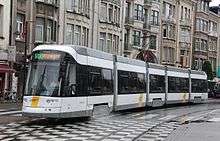Trams in Antwerp
The Antwerp tramway network (Dutch: het Antwerpse tramnet) is a network of tramways forming part of the public transport system in Antwerp, a city in the Flemish region of Belgium. The network is operated by the Flemish region's transportation company De Lijn. As of April 2017, it featured fourteen lines, eight of which pass partially underground (known as Antwerp Pre-metro).
| Antwerp tramway network | |||||||||||||||||||
|---|---|---|---|---|---|---|---|---|---|---|---|---|---|---|---|---|---|---|---|
 | |||||||||||||||||||
 An Albatros tram in Antwerp, 2016. | |||||||||||||||||||
| Operation | |||||||||||||||||||
| Locale | Antwerp, Belgium | ||||||||||||||||||
| |||||||||||||||||||
| |||||||||||||||||||
General description
The Antwerp tram system features segments with different characteristics, from following along with street traffic to tunnels, which do not differ much from subway rail setup — 1,000 mm (3 ft 3 3⁄8 in) track gauge and a 600 volts catenary power feed.
The tram network is connected to the Flemish Tram and Bus Museum and heritage rides are regularly organised over the network with historical vehicles.
Horse trams, and Omnibus
Horse-drawn trams were the predecessor of nowadays electric trams. The first mention for the existence of the «American Tram» (fr. Tramway Américain) as the horse tram was referred to, was in correspondance addressed to the citywide proprietors Ed. Paujaurd’hui and A. Edvard on June 27, 1865. However, just 6 years later (March 14, 1871) the city council allowed for the construction of tram lines. The first horse tram line opened in Antwerp on May 25, 1873. It linked the church in Berchem (now a district of Antwerp) with the Meir, an avenue in the city center.
Nine years later, already 9 lines of horse-drawn trams existed in Antwerp. There was also one omnibus route. The public transport of Antwerp was exploited by 9 different companies. One of them operated an omnibus, the other eight various horse tram routes.
Electrification
The work permit for electrifying the tram system was granted to CGTA on March 12, 1902 just after half year from applying. (November 22, 1901). Along with electrification plans were made to rebuild lines from 1,435 mm (4 ft 8 1⁄2 in) gauge to 1,000 mm (3 ft 3 3⁄8 in).
The works started on the omnibus route Draakplaats — Grote Markt (now - route № 11). In fact this was the first real tram line onthis routewhich, since omnibuses are road transport, rather than rail transport. Therefore, there was no infrastructure before electrifying this line.
On May 6, 1902 following the former omnibus route, tracks were laid, from Draakplaats to Nieuwstraat. After that the tracks started to be installed along with the electrification of the horse-drawn line on the boulevard ring (Leien). For a time, out of service omnibusses temporarily replaced horse-drawn cars. On July 9, 1902, horse drawn cars started to move on a former omnibus route segment from Nieuwstraat to Grote Markt.
The first gantry for an electric tram line was installed on June 10, 1902 on the Kunstlei boulevard (now Frankrijklei), between the crossing of De Keyserlei and the Gemeenteplaats (now Fr. Rooseveltplaats). On August 13, 1902 the catenary was connected to the temporary electric power substation, which was erected in a tram depot on Boudewijnstraat. Then the electric tram tests started. The normal operation of an electric tram started on September 2, 1902. First there was a mix of electric trams and horse cars on the line. Later the horse-drawn trams left the boulevards of Antwerp - forever.
Tram lines since 8 December 2019
There are currently many roadworks and changes going on in Antwerp, the tramlines have constant small changes every month, this information may be outdated.
| line | route | journey time* | average speed*
--> |
|---|---|---|---|
| 1 | Luchtbal (P+R Luchtbal) – Zuid | ? min | ? km/h |
| 2 | Merksem (P+R Keizershoek) – Hoboken (Kioskplaats) | 46 min | ? km/h |
| 3 | Zwijndrecht (P+R Melsele) – Merksem (P+R Keizershoek) | 40 min | 22 km/u |
| 4 | Hoboken (Lelieplaats) – Silsburg | 16/29 min** | ? km/h |
| 5 | Wijnegem – Linkeroever (P+R) | 37 min | 26 km/h |
| 6 | P+R Luchtbal – Olympiade (P+R) | ? min | 17 km/h |
| 7 | MAS – Mortsel (Gemeenteplein) | 28 min | 17 km/h |
| 8 | Station Astrid - Wommelgem (P+R) | ? min | 24 km/h |
| 9 | Linkeroever (P+R) – Eksterlaar | 26 min | ? km/h |
| 10 | (Schoonselhof) – Wijnegem | ? min | ? km/h |
| 11 | Melkmarkt – Antwerpen-Berchem railway station | 19 min | ? km/h |
| 12 | Sportpaleis – Centraal Station | 25 min | ? km/h |
| 15 | Linkeroever (P+R) – Boechout (P+R Capenberg) | 44 min | ? km/h |
| 24 | Havenhuis – Deurne (Silsburg) | 24 min | ? km/h |
Rolling stock
In August 2012, De Lijn ordered a fleet of Flexity 2 trams from Bombardier, including 28 for Antwerp. These would replace many of the older PCC trams, and displace Hermelijn trams onto other routes.[1]
PCC cars are regularly used in coupled pairs. On 6 November 2017, De Lijn started testing so-called "mega-trams" consisting of two Hermelijnen coupled together, on route 3. The resulting trains are 61 metres long and can carry 500 passengers. Their use would increase the capacity of the underground sections of the line where the minimum headway has already reached its limit of 2 minutes. They may be introduced into service at the start of 2018.[2]
See also
- Antwerp Pre-metro
- Flemish Tram and Bus Museum
- List of town tramway systems in Belgium
- Trams in Belgium
.svg.png)